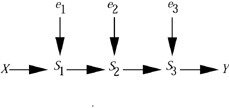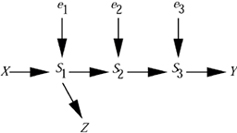Date: May 11, 2006
From: UCLA Epidemiology Class - EPIDEM 200C Methods III: Analysis
Subject: Back-door criterion and epidemiology
Question to author
The definition of the back-door condition (Causality,
page 79, Definition 3.3.1) seems to be contrived. The exclusion of
descendants of X (Condition (i)) seems to be introduced as an after
fact, just because we get into trouble if we dont.
Why cant we get it from first principles;
first define sufficiency of Z in terms of
the goal of removing bias and, then, show
that, to achieve this goal, you neither want nor need
descendants of X in Z.
Author answer:
The exclusion of descendants from the back-door criterion
is not a contrived "fix", but is based indeed on first principles.
The principles are as follows:
We wish to measure a certain quantity (causal effect) and,
instead, we measure a dependency P(y|x) that results
from all the paths in the diagram, some are spurious
(the back-door paths) and some are genuine (the directed paths).
Thus, we need to modify the measured dependency
and make it equal to the desired quantity. To do it
systematically, we condition on Z while ensuring that:
- We block all spurious paths from X to Y,
- We leave all directed paths unperturbed
- We create no new spurious paths
Principles 1 and 2 are accomplished by blocking
all back-door paths and only those paths.
Principle 3 requires that we do not
condition on certain descendants of X,
because such descendants may create new spurious paths
between X and Y.
To see why, consider the path

The intermediate variables,
S1, S2..., (as well as Y)
are affected by noise factor e1, e2,...
which are not shown explicitly in the diagram.
However, under magnification, the chain unfolds into
the graph:

Now imagine that we condition on a descendant Z
of S1

Since S1 is a collider, this creates dependency between
X and e1 which is equivalent to a back-door path

By principle 3, such spurious paths should not be created.
Note that a descendant Z of X that is not
also a descendant of some Si escapes this exclusion;
it can safely be conditioned on without introducing
bias. (Though it may decrease the efficiency of the associated estimator
of the causal effect of X on Y.)
Further questions from Reader:
This is a reasonable explanation (for excluding
descendants of X,) but it has two shortcomings:
- It does not address cases such as

which occur frequently in epidemiology, and where tradition
permits the adjustment for Z = {C,F}
- The explanation seems to redefine confounding
and sufficiency to represent something different
than what they have meant to epidemiologists in the past
few decades. Can we find something in graph theory that is
closest to their traditional meaning?
Author's Answer
-
The criterion given actually does cover the case
you cite.
The graph tells us that conditioning on Z does not introduce
extra dependencies, hence, the dependency of Y on X
should disappear in each stratum of Z.
If we happen to measure such dependence in
any stratum of Z, it must be that the model is wrong,
i.e., either there is causal effect of X on Y, or some other
paths exist that are not shown in the graph.
Thus, if we wish to test the (null) hypothesis
that there is no causal effect of X on Y,
adjusting for Z = {C,F} is perfectly legitimate,
and the graph shows it (i.e., C and F are
non-descentant of X). However, it is not
a legitimate adjustment for assessing the causal
effect of X on Y, and the back-door criterion
tells us so, because the graph under this task is

F becomes a descendant of X, excluded by
the back-door criterion.
-
The principles cited above are perfectly
compatible with the definitions of confounding
found in traditional epidemiology (after we clean up
misguided statements made by some epidemiologists).
If they sound at variance with traditional epidemiology,
it is only because traditional epidemiologists
did not have a formal system of removing
and adding dependencies. All they had was
healthy intuition; graphs translates this intuition
into a formal system of closing and opening paths,
We should realize that before 1985,
causal analysis in epidemiology was in a state of chaos,
or, as I put it politely: "a state of healthy intuition."
Even the idea that confounding stands
for a "difference between two dependencies, one
that we want to measure, the other that we do measure"
was resisted by many
(see chapter 6 of Causality), because they
could not express the former mathematically.
As to finding "something in graph language that is
closest to traditional meaning," we can
do much better. Graphs provide the actual meaning of
what we call "tradition meaning".
In other words, graph theory is formal, traditional meaning is just
intuition. Suppose we find a conflict between the two,
who should we believe? tradition or formal mathematics?
Luckily, we will never find such conflict. Why? because tradition is
slippery and
healthy intuition is slippery and one can always say:
what they really meant was different...
In short, what graphs gives us is
the ONLY sensible interpretation of
the "traditional meaning of epidemiological concepts."
Return to Discussions





